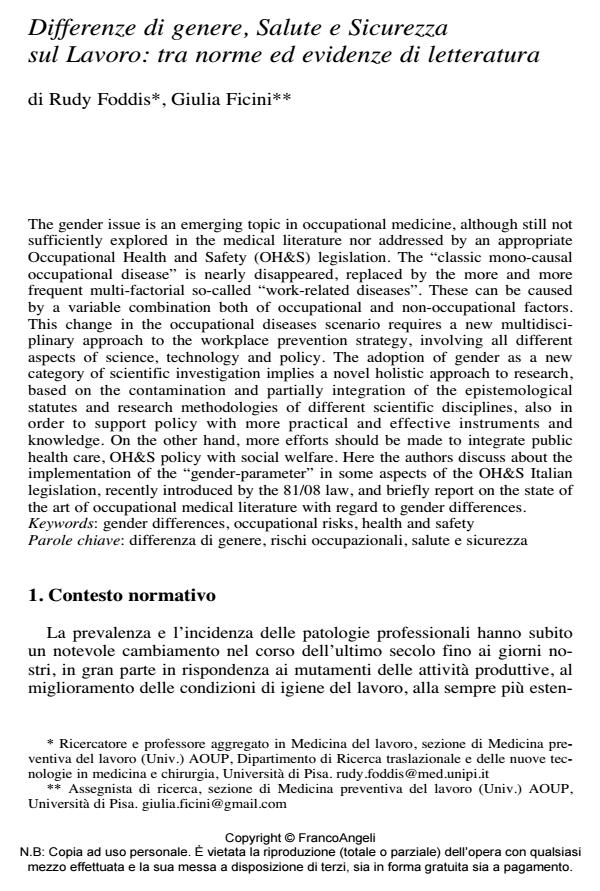Differenze di genere, Salute e Sicurezza sul Lavoro: tra norme ed evidenze di letteratura
Journal title SALUTE E SOCIETÀ
Author/s Rudy Foddis, Giulia Ficini
Publishing Year 2014 Issue 2014/1
Language Italian Pages 13 P. 168-180 File size 525 KB
DOI 10.3280/SES2014-001014
DOI is like a bar code for intellectual property: to have more infomation
click here
Below, you can see the article first page
If you want to buy this article in PDF format, you can do it, following the instructions to buy download credits

FrancoAngeli is member of Publishers International Linking Association, Inc (PILA), a not-for-profit association which run the CrossRef service enabling links to and from online scholarly content.
The gender issue is an emerging topic in occupational medicine, although still not sufficiently explored in the medical literature nor addressed by an appropriate Occupational Health and Safety (OH&S) legislation. The "classic mono-causal occupational disease" is nearly disappeared, replaced by the more and more frequent multi-factorial so-called "work-related diseases". These can be caused by a variable combination both of occupational and non-occupational factors. This change in the occupational diseases scenario requires a new multidisciplinary approach to the workplace prevention strategy, involving all different aspects of science, technology and policy. The adoption of gender as a new category of scientific investigation implies a novel holistic approach to research, based on the contamination and partially integration of the epistemological statutes and research methodologies of different scientific disciplines, also in order to support policy with more practical and effective instruments and knowledge. On the other hand, more efforts should be made to integrate public health care, OH&S policy with social welfare. Here the authors discuss about the implementation of the "gender-parameter" in some aspects of the OH&S Italian legislation, recently introduced by the 81/08 law, and briefly report on the state of the art of occupational medical literature with regard to gender differences.
Keywords: Gender differences, occupational risks, health and safety
- Migliorare la salute delle donne nei luoghi di lavoro: aspetti normativi e gestione dei rischi. Una ricerca in Toscana Rita Biancheri, Silvia Cervia, in STUDI ORGANIZZATIVI 1/2015 pp.44
DOI: 10.3280/SO2015-001003 - [Risk assessment and health surveillance from a gender perspective: proposal for operational tools] Rudy Foddis, Giulia Ficini, Alfonso Cristaudo, Alessandra Pistelli, Annalaura Carducci, Elisa Caponi, Rita Biancheri, Antonella Ninci, Chiara Breschi, Andrea Cristaudo, Antonella Basso, Roberta Bonfiglioli, Francesca Larese Filon, Silvia Simonini, Giovanna Spatari, Paola Tomao, Maria Gabriella Verso, Maria Luisa Scapellato, in Giornale Italiano di Medicina del Lavoro ed Ergonomia /2025 pp.214
DOI: 10.4081/gimle.635
Rudy Foddis, Giulia Ficini, Differenze di genere, Salute e Sicurezza sul Lavoro: tra norme ed evidenze di letteratura in "SALUTE E SOCIETÀ" 1/2014, pp 168-180, DOI: 10.3280/SES2014-001014